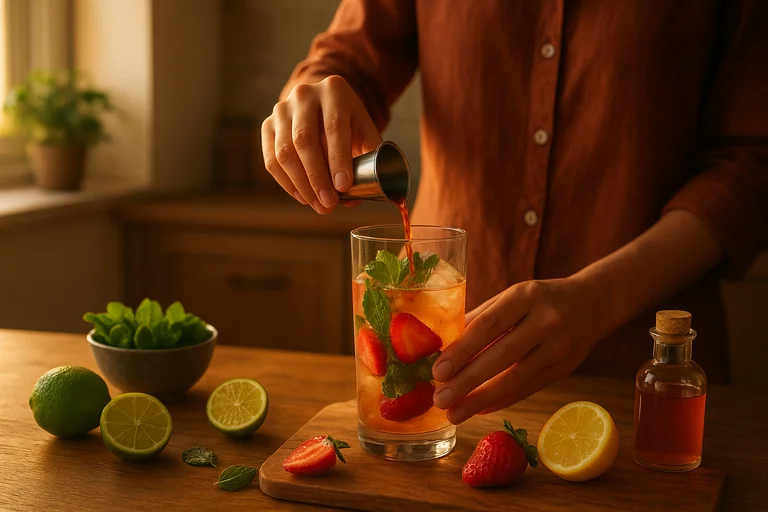A 2 minute assessment to get a personalized mental health or alcohol recovery plan.
Wine can lead to weight gain, not automatically but often, because it adds energy-dense alcohol calories at about 7 kcal per gram, suppresses fat burning for hours, nudges you toward higher-calorie food choices, and disrupts sleep, with all these effects accumulating over weeks and months if calories aren't consistently offset elsewhere.
What You'll Discover:
- How alcohol's 7 kcal per gram adds up faster than most people realize
- Why wine suppresses fat burning and shifts metabolism toward storage
- The link between alcohol, sleep disruption, and next-day hunger
- Mixed evidence on moderate drinking and why dose matters more than wine type
- Practical strategies to enjoy wine without weight gain
- Evidence-based treatment options including naltrexone when cutting back is difficult
A standard 5-oz glass of table wine contains about 14 g of pure alcohol (one U.S. "standard drink"), which brings about 98 kcal from ethanol alone, and typically more when you include small amounts of carbohydrate and any additional pour. Multiple glasses add up fast.
Research on light-to-moderate alcohol intake and weight is mixed (some cohorts show little change), but heavy or regular intake is much more consistently linked with weight gain, especially when drinking drives extra eating or sleep loss.
All that said, type matters less than dose and context. For weight, ethanol calories dominate. Dry wine may have fewer non-alcohol sugars than sweet wine, but total alcohol plus serving size plus behavior after drinking (snacking, sleep) are what move the scale.
With that in mind, here's exactly how wine affects your weight, what the research shows, and how to enjoy wine without creeping weight gain.
Why wine can push weight up even when it feels light
Alcohol calories are dense and easy to underestimate - Ethanol delivers about 7 kcal per gram, second only to fat (9 kcal/g). A U.S. standard drink is defined as 14 g of pure alcohol, regardless of beverage. A typical 5-oz (about 150 ml) glass of 12 percent wine is one standard drink, bringing about 98 kcal from ethanol, plus non-alcohol calories. Two generous pours, three nights per week, can quietly add hundreds of calories weekly. The NIAAA alcohol calorie calculator illustrates how quickly weekly calories stack up, even before you count cheese boards or dessert. These "liquid calories" are rarely offset later because most of us don't feel as full after drinking compared with eating the same calories.
Alcohol shifts your metabolism toward storage - Classic chamber and meal studies show that when alcohol is on board, the body burns alcohol first and suppresses fat oxidation for hours, meaning the fat and carbs in your dinner are more likely to be stored. This "fat-sparing" effect doesn't mean alcohol has no calories; it means those calories "displace" fat burning, and excess energy is parked as fat. Over time, that pattern supports weight gain.
Wine can disinhibit eating and disturb sleep - After a couple of glasses, resolve weakens and appetite rises; studies and reviews consistently find higher food intake during and after drinking episodes. Then there's sleep: alcohol shortens sleep latency but suppresses REM early and fragments sleep later, leaving you hungrier and less active the next day, a compound effect that supports weight gain.
What the research says about wine and weight
The mixed picture at lower doses - Systematic reviews and cohorts often report heterogeneous associations between light-to-moderate alcohol and body weight. Lifestyle confounding (diet quality, physical activity, socioeconomic status) can blur cause-and-effect. In several analyses, heavier consumption correlates with weight gain, while light intake shows small or neutral changes on average. Translation: at lower intakes some people compensate elsewhere; many don't. For example, a large cohort analysis found only minor weight changes overall with increased alcohol intake, but men who increased consumption well beyond moderation gained more weight, suggesting dose and pattern dominate, not whether calories came from wine versus other drinks.
Beverage type - wine versus beer versus spirits - For body weight, what matters most is total ethanol plus serving size. A 5-oz glass of wine, a 12-oz beer (5 percent), or a 1.5-oz 80-proof spirit each contain 14 g alcohol, similar ethanol calories. Beer adds carbohydrate; sweet wines add sugar; cocktails add a lot via mixers. But in head-to-head population work, beverage-specific differences are small compared with how much and how often you drink.
Four pathways from a glass of wine to weight gain
Calorie add-on without compensation - Wine calories layer over your day instead of replacing other intake. If you don't consciously subtract elsewhere, repeated small surpluses add up. The NIAAA calculator is a sobering visualization.
Metabolic tilt toward storage - When you drink wine with dinner, the body preferentially clears alcohol and down-regulates fat burning, increasing post-meal fat retention.
Food choices drift upward - Alcohol increases hedonic drive and reduces restraint, making energy-dense foods more likely: cheese boards, fried starters, late-night bites. Meta-analysis supports higher energy intake with alcohol exposure, particularly at heavier levels.
Sleep to appetite loop - Alcohol fragments sleep (REM suppression, rebound, awakenings). Poor or short sleep increases next-day appetite and snacking and saps workout motivation, worsening energy balance.
But wine is heart-healthy, right
Public-health messaging has shifted: no amount of alcohol is "safe" for health overall, and alcohol causes cancer (notably breast, colorectal, liver, and others). Recent U.S. discussions have even proposed adding cancer warnings to alcohol labels, highlighting risk from the first drink. Whatever you decide for your health, less is better from a risk standpoint, and, for many, for weight control.
How many calories are in common wine pours
5-oz glass of 12 percent ABV wine (standard drink): about 98 kcal from ethanol plus small carbohydrate calories (varies by dryness). "Restaurant pour" 6 to 9 oz: scale the above, about 118 to 176 plus kcal from ethanol alone. Sweet wines/dessert wines: add meaningful sugar calories on top of ethanol. Use standard drinks (14 g alcohol per drink) as your anchor; bigger glasses and higher ABV wines quietly multiply kcal.
Added sugars: While dry wines have little residual sugar, sweet wines, wine coolers, and spritzers with sweetened mixers can push you toward the added sugars limit, the Dietary Guidelines recommend less than 10 percent of daily calories from added sugars.
Practical ways to enjoy wine without creeping weight gain
Decide the dose before the pour - Choose alcohol-free nights by default and pre-commit your max glasses on social nights. Use 5-oz wine glasses or measure the first pour to calibrate your eye. (Large bowls invite 8 to 10 oz pours.) Aim for 1 drink or less per hour and finish 3 hours or more before bed to reduce sleep disruption and next-day hunger.
Pivot to drier choices and smaller sizes - Prefer dry wines or lower-ABV styles; skip dessert wines as routine choices. Alternate with sparkling water (citrus, bitters) between glasses.
Pair with protein plus fiber; skip sugar mixes - Eat protein plus fiber before wine to moderate appetite drift. Avoid sweet mixers (spritzers with soda/juice). Keep added sugars within the less than 10 percent guideline.
Protect sleep to protect weight - Alcohol is not a sleep aid. If you drink, keep it early and light, and hold your normal bedtime. Better sleep improves hunger control and gym consistency.
Audit the week, not the night - Tally total standard drinks and late-night food. Swap a second glass for seltzer plus lime 2 to 3 times per week and you'll often save hundreds of calories monthly. Use NIAAA's calorie calculator to visualize your changes.
If you're trying to cut back (and it's not sticking)
You're not alone. Alcohol's reinforcement makes "just one more" feel compelling, especially in high-risk windows (after work; celebrations). A clinician can help you build skills (triggers, scripts, sleep routines) and, for many adults who are medically appropriate, add naltrexone oral tablets, which reduce heavy-drinking days and craving when used with counseling. That combination often makes calorie control simpler (fewer binges, less late-night food). Your clinician will review safety (no current opioid use, liver history) and typical dosing (commonly 50 mg/day).
Safety note: If you've been drinking heavily, don't stop abruptly without medical advice; alcohol withdrawal can be dangerous and may require supervised care before longer-term change.
Frequently asked questions
If wine has fewer carbs than beer, why would it cause weight gain? - Because ethanol calories still count, and at about 7 kcal/g they're dense. Alcohol also suppresses fat burning for hours, pushing dinner calories toward storage. Drink type matters less than total alcohol and behavior after drinking.
Is red wine better than white for weight? - Not meaningfully for weight. ABV and pour size dominate. Some red wines are higher ABV than whites, making a "standard pour" more caloric even if the glass looks the same. Choose by dose and timing, not color.
What about wine resveratrol and metabolism? - Lab findings on polyphenols don't cancel out alcohol's calorie and metabolism effects at real-world doses. For weight, focus on total alcohol and eating/sleep patterns, not purported offsets.
Can I just burn off the wine with exercise? - Exercise helps, but alcohol's fat-oxidation suppression and sleep disruption make "burning it off" less efficient than not drinking it (or drinking less). A smarter plan is dose control, early timing, and consistent activity.
Does wine cause belly fat specifically? - Visceral fat responds to energy surplus and hormones, not brand or color. Wine contributes via calories, storage tilt, and behavior; repeated surpluses, no matter the source, raise central adiposity risk. Population data link higher alcohol (any type) with higher weight; beverage differences are minor compared with dose.
Is there a safe amount for weight control? - There's no universal safe dose. Many people maintain weight at low intake by compensating elsewhere, but heavy or regular intake (and binge patterns) frequently increase weight. If you choose to drink, use standard drinks, set weekly caps, and protect sleep.
Ready to understand where you stand?
Curious whether your wine habit is adding hidden calories or edging into risky territory? Our quick, confidential alcohol assessment gives you a private, research-based readout you can share with your clinician, plus personalized guidance on safer next steps.
Start your 3-minute alcohol use assessment




